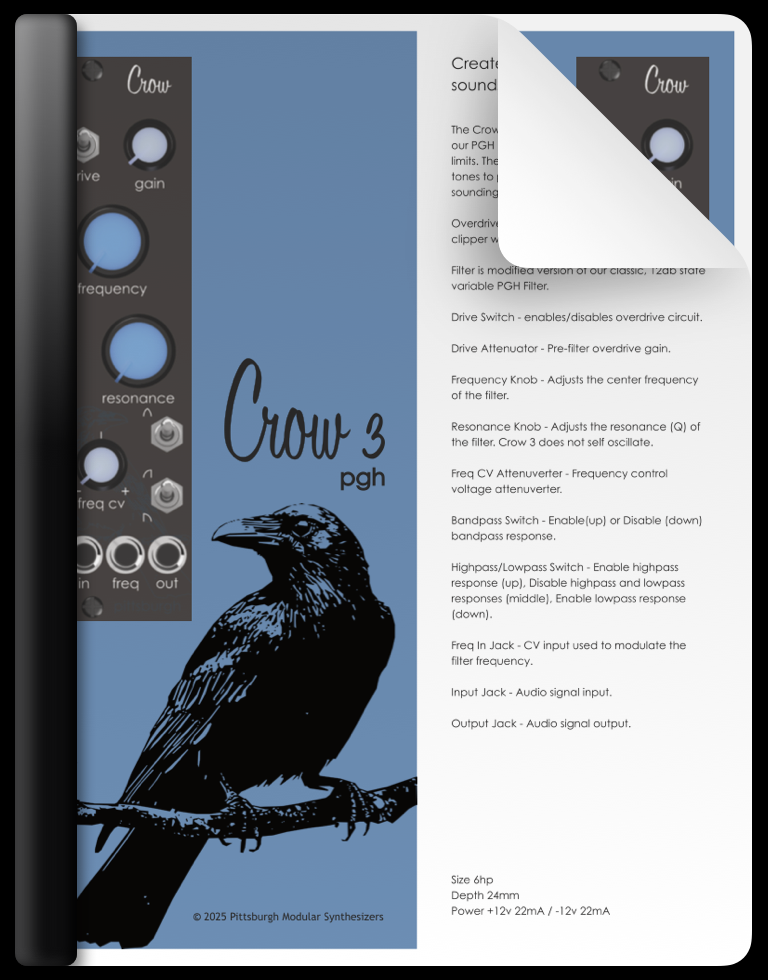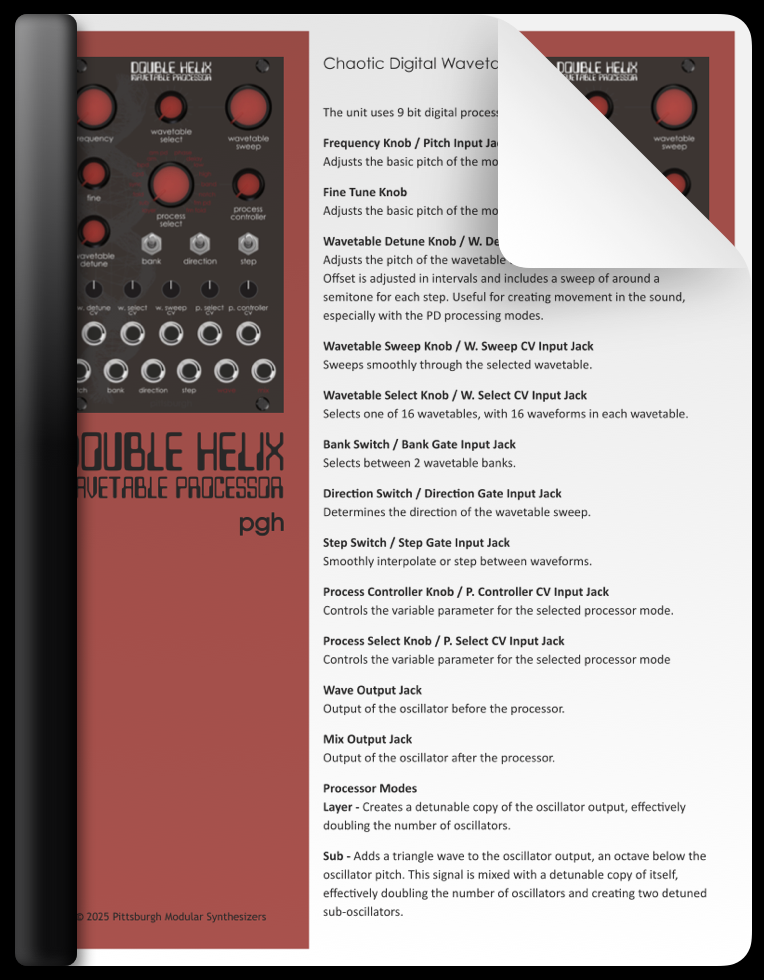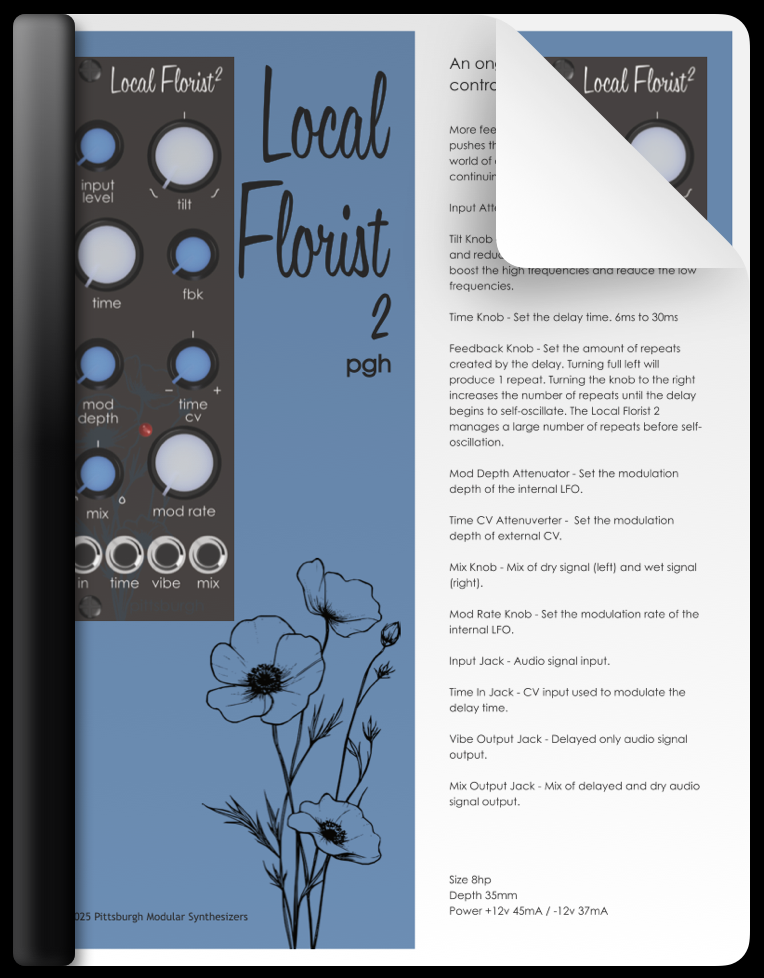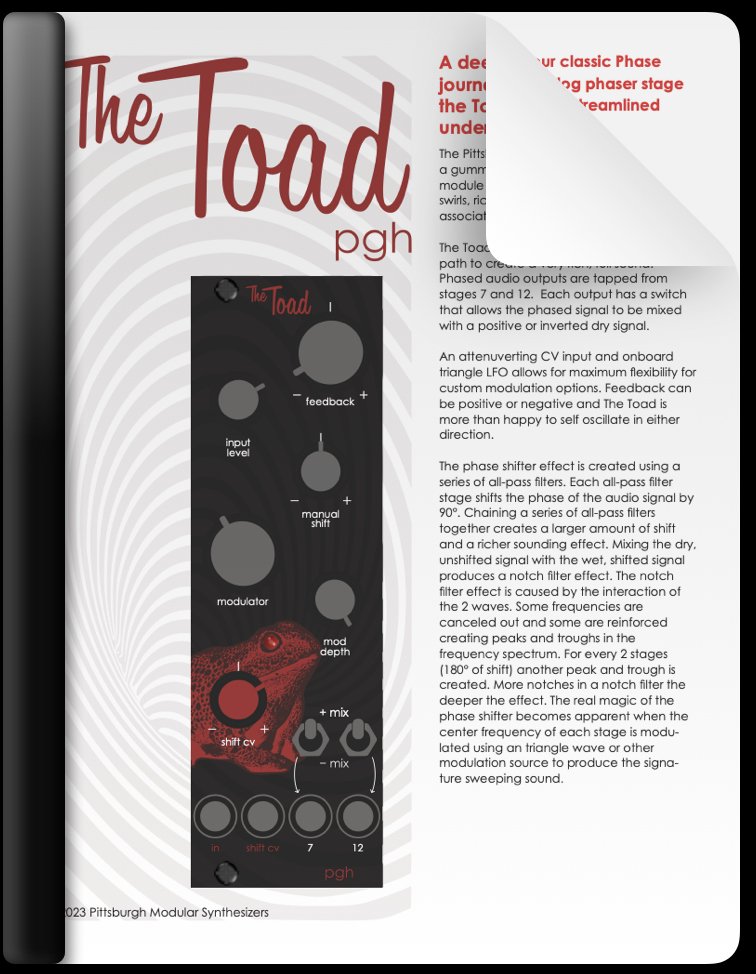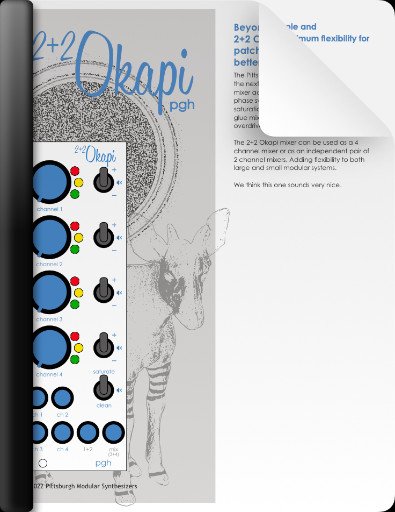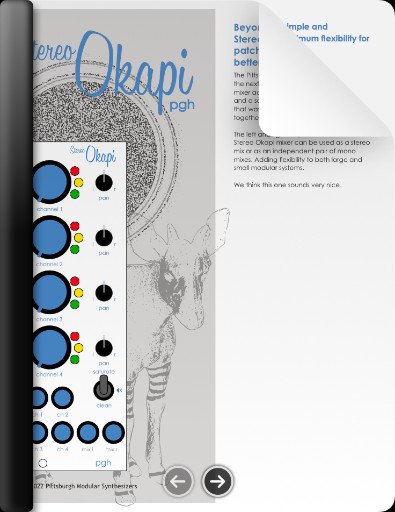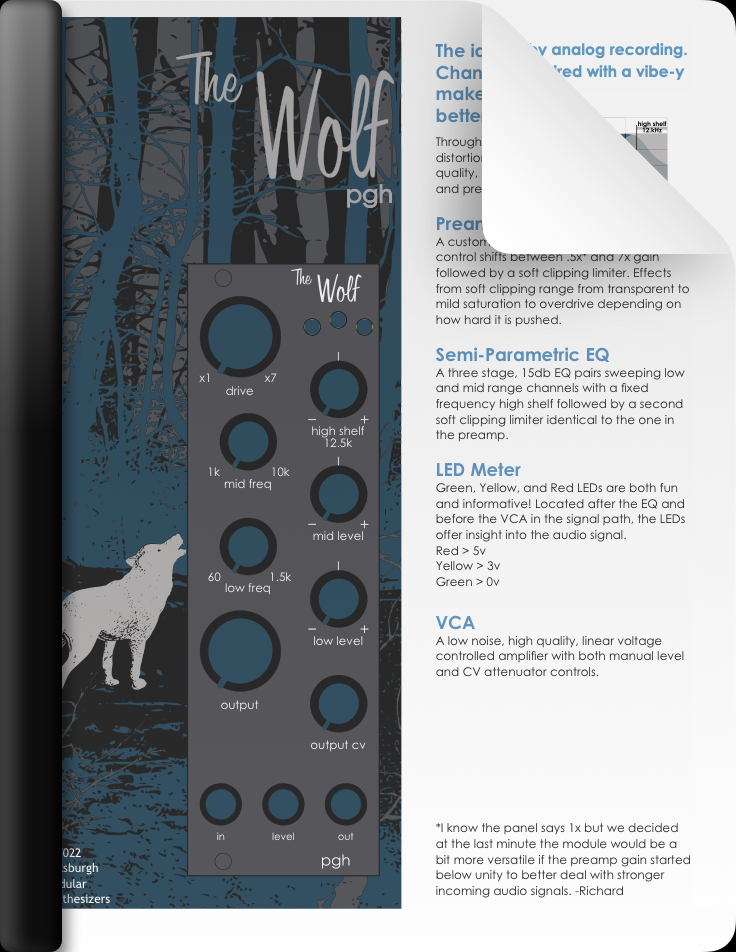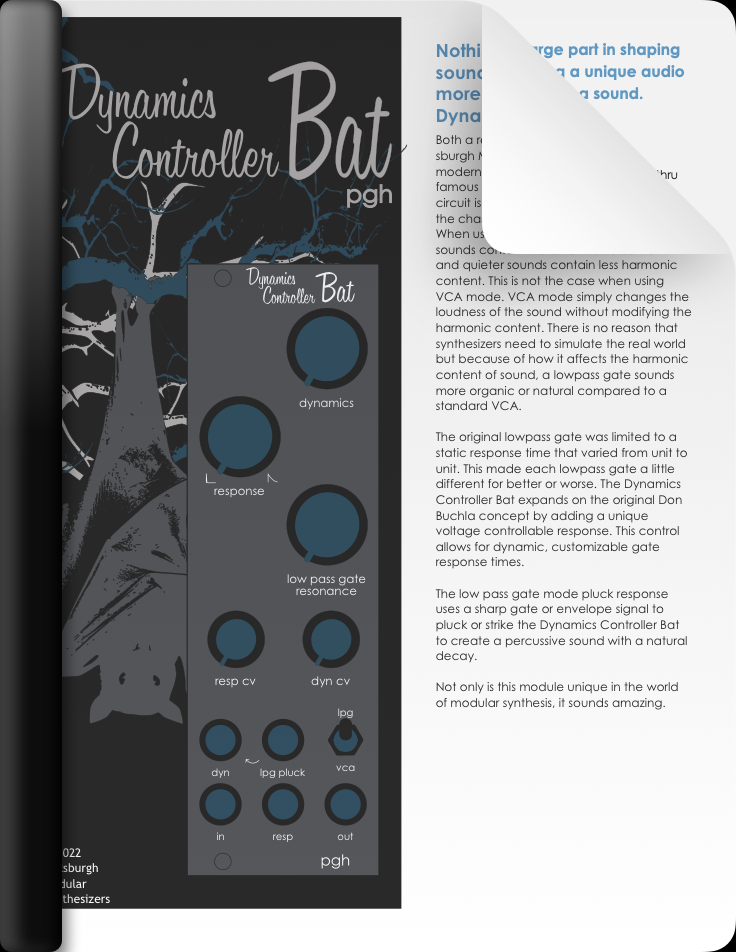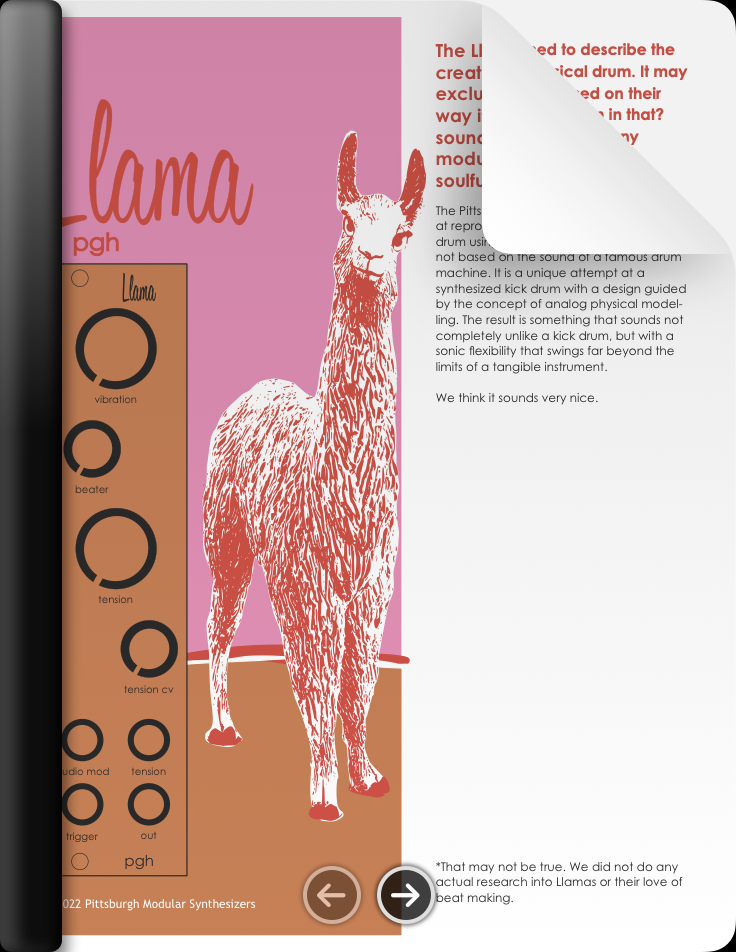Modular Synthesis Safari
Limited Production Experiments
Order Now
A glimpse into our design process, the Safari modules give Richard and Michael an opportunity to highlight interesting concepts, test ideas for future instruments, and scratch their creative itch. We have built a small number of each of the Safari modules and because these designs are meant to be a proof of concept or work in progress, we do not plan on making more. New research into analog synthesis is important to us and there is so much left to explore!
Series 9
Crow 3
Order Now
The latest iteration of the Crow pairs the destructive power of the original, Safari Series #1 module with the smoothest iteration yet of the Pittsburgh Filter sound. This module can sound beautiful or brutal or both.
Ultra-High Gain Preamp
The preamp, designed for the original Crow, pairs a massive amount of gain with a custom limiting circuit. This circuit provides unmatched dimensions of overdrive without sounding harsh. Additionally, the circuit can be switched off to allow for a completely clean exploration of the Pittsburgh Filter sound.
PGH Filter
The PGH filter has been continually refined over the last 13 years of research and altered to fit the demands of each system that it has been a part of. One of its unique defining characteristics is its ability to offer a complete sweepable range without any noticeable dead spots. Dead spots are uneven / muted portions of the swept range due to non-linearities in the circuitry. The PGH filter has no noticeable dead spots and is voiced to interact well with the high-gain preamp circuit. The result is a rich, even, fully sweepable range.
The Crow 3 showcases our 12db State Variable “no-dead-spot” Filter. The classic PGH Filter sound with manually selectable and stackable filter responses. Lowpass, bandpass, and highpass filter responses can be enabled or disabled for instant parallel processing.
Documentation available below.
Double Helix Wavetable Processor
Order Now
Ten years ago we created a digital 9-bit wavetable oscillator module called the Double Helix with a colleague of ours from the UK. After producing 5 or 6 prototypes, the limitations of our small company forced us to shelve the finished module before a full production run was realized. Recently, we made the mistake of gifting one of these ancient prototypes to our good friend MagicalSynthAdventure who promptly posted a video and story on SonicState that caused our inbox to explode. So, due to popular demand and despite its quirks and limitations, the Double Helix Wavetable Processor is finally here.
The Double Helix is a chaotic, somewhat stable, lo-fi, 9-bit digital wavetable oscillator with a built-in waveform effects processor.
2 banks of 16 sweepable wavetables with 16 sweepable waves
16 effects processor modes with a modulatable controller
Unique 9-bit resistor ladder DAC
High frequency response is limited by the range of the vintage processor.
Fair to poor volt per octave tracking at the high frequencies above F#5, matching the response of the original.
The circuitry and code of this Double Helix matches the original prototypes but the panel size has been updated to a more manageable 16hp.
Available with red or gray knobs.
Documentation available below.
Local Florist 2
Order Now
More feedback and a larger palette of options push the Local Florist 2 deeper into a unique world of experimentation. The Local Florist 2 offers a range of possibilities effects including flanging (kinda), chorus (yes), reverb (true), spring-y feedback sounds (all day), karplus strong (not really, but sorta), vibrato (yes), plucky percussive string sounds (yes), and general robot space sounds (often).
The Local Florist utilizes an analog bucket brigade (BBD) chip with a 3ms - 28ms delay time along with an updated second generation feedback circuit to produce a large bouquet of sonic textures perfect for any occasion.
This module expands on the original Local Florist module in a few ways. The Feedback circuit has been enhanced to allow even more feedback before it falls into self oscillation and a tilt control has been added to manipulate the frequency response of the wet signal.
Thank you for continuing to support your Local Florist!
Documentation available below.
Series 8
Snakes Dual Gate Sequencer
Order Now
The Pittsburgh Modular Snakes is an 8hp dual 16 step gate sequencer created to work with our drum modules or any other Eurorack modules that enjoy gate signals. Snakes includes 2 independent 16 step sequencers. Each sequencer offers mute, reset, clock division, per step chance, euclidean pattern generators, per step gate length accents, sequencer direction, per step morphing, and per step ratcheting. The sequences share a tap tempo clock or external clock source, pattern memory, and can be chained together to create a 32 step sequesncer.
Safari Series 8 Documentation
Series 7
Local Parks Experimental High Harmonic Analog Oscillator
Order Now
The Pittsburgh Modular Local Parks oscillator is drawn from our waveform manipulation research. Advanced approaches to wave shaping throughout the module showcase new sounds and unique waveforms.
Our in-depth experimentation has created pulse waves which can be manipulated in multiple dimensions utilizing both Pulse Width and Pulse Shift. Pulse Shift creates an adjustable “step” within the pulse wave to further enhance the harmonic content of the wave. The wave used to create the pulse can be switched between sine and saw for additional sonic variation.
The Blade Wave is a morphing saw wave pitched one octave above the core frequency of the oscillator that smoothly shifts back to the core frequency as it changes shape. This creates a chorus-like effect on the sound of the Blade Wave without ever falling out of tune.
A Binary Logic waveform further expand the distinct sonic palette of the Local Parks. First utilized in our Narwhal Cymbal module, this waveshaper uses analog binary logic to create everything from gate effects to atonal bell like tones. The pulse and blade waves can be summed with the binary output for even more complex results.
Local Parks includes a built-in voltage controlled modulator to handle the bulk of modulation needs. This ensures that Local Parks can be a dynamic oscillator that produces evolving, high harmonic sounds within any eurorack setup.
The Toad 12 Stage Analog Phase Shifter
Order Now
The Pittsburgh Modular Toad phase shifter is a gummy, 12 stage, all analog effect module designed to expand on the classic swirls, rich swooshes, and doppler effects associated with the phaser.
The Toad has a single 12 stage audio signal path to create a very rich, full sound. Phased audio outputs are tapped from stages 7 and 12. Each output has a switch that allows the phased signal to be mixed with a positive or inverted dry signal.
An attenuverting CV input and onboard triangle LFO allows for maximum flexibility for custom modulation options. Feedback can be positive or negative and The Toad is more than happy to self oscillate in either direction.
History and Theory Behind the Phase Shifter
The origin of the phase shifter as an electronic effect starts with the studio tape technique of flanging. The technique involved playing identical copies of audio through two different tape machines simultaneously and pressing on the flange of one machine to slow down the tape. This action shifted the sound slightly out of sync to the first tape machine and created a moving notch filter effect.
Electronically, the effect is created using a series of all-pass filters. Each all-pass filter stage shifts the phase of the audio signal by 90°. Chaining a series of all-pass filters together creates a larger amount of shift and a richer sounding effect. Mixing the dry, unshifted signal with the wet, shifted signal produces a notch filter effect. The notch filter effect is caused by the interaction of the 2 waves. Some frequencies are canceled out and some are reinforced creating peaks and troughs in the frequency spectrum. For every 2 stages (180° of shift) another peak and trough is created. More notches in a notch filter the deeper the effect. The real magic of the phase shifter becomes apparent when the center frequency of each stage is modulated using an triangle wave or other modulation source to produce the signature sweeping sound.
Safari Series 7 Documentation
Series 6
2+2 Okapi Mixer & Stereo Okapi Mixer
Order Now
Two different versions of the same idea. The 2+2 Okapi and Stereo Okapi mixers add a vintage console vibe to sounds by using soft compression and saturation to glue the mix together.
Both modules include per channel LED monitoring and two mixing modes. Clean mode utilizes the mixing circuit of the SV-1 for a transparent mixer that works great with both audio and CV signals. Saturate mode adds soft compression and saturation to the mix. This effect can be used subtly to add vibe or pushed further to press additional harmonics out of the mix. A global mute is available on both versions of the mixer as well.
The 2+2 Okapi offers a mute and phase switch for each channel. The top two channels can be split off allowing the module to be used as two independent mixers. This is very handy for both small and large systems.
The Stereo Okapi has a pan pot for each of the four channels along with a left and right output. Perfect as an output mixer or a sub-mixer for drums.
Documentation available below.
Koi Buffered Splitter
Order Now
The Koi is pretty simple but very handy. Three fully buffered mults that are chained together. Each section has a dedicated LED for keeping an eye on any type of signals. We know you have your choice of fish themed eurorack mults, but we think ours is the best.
Size: 4HP
Depth: 24mm
Power: +12v 25 mA / -12v 25 mA
Safari Series 6 Documentation
Series 5
Narwhal Cymbal
(sold out)
Michael’s partner wanted a module called Narwhal that removes reverb. That seemed a little ambitious for a handful of resistors, capacitors, and op-amps, but we do like Narwhals and we were working on a new cymbal circuit that needed a name. All that said, the Narwhal Cymbal module sounds very nice.
The Pittsburgh Modular Narwhal is an attempt at reproducing the sound of a physical cymbal using analog circuitry. This module is not based on any famous machine. It is a unique attempt at a synthesized cymbal with a design guided by the concept of analog physical modeling. The result is something that sounds not completely unlike a cymbal, but with a sonic flexibility that swings far beyond the limits of a tangible instrument.
Documentation available below.
Elephant Drum
(sold out)
The Pittsburgh Modular Elephant is a re-imaging of the classic Pollard Syndrum. Although not a clone of the original circuits, the Elephant was inspired by the flexibility and musicality of the vintage instrument. We think this one also sounds very nice.
A variable waveform oscillator is rhythmically modulated (or not) to create complex percussive sounds. Built in Modulator (LFO) and Tension (percussive decay envelope) add depth and movement the oscillator. Voltage control over Tuning (pitch) and Material (waveform) allow for creative patching options.
Documentation available below.
Safari Series 5 Documentation
Series 4
The Wolf
Order Now
The Wolf is a Channel Strip VCA designed to improve and provide more control over any input source. It does this using three unique circuits.
Wolf Preamp
The Wolf’s Preamp is a custom preamplifier with variable gain control shifts between .5x and 7x gain followed by a soft-clipping limiter. The soft-clipping limiter is a way to control the amplitude of the signal while avoiding harsh distortion. Depending on how hard it is pushed, the results of running a signal through this circuit range from fully transparent to warm saturation to overdrive.
Wolf Three-Stage Semi-Parametric 15db EQ
The Wolf has a three-stage Semi-Parametric 15db EQ featuring sweeping low and mid-range channels, as well as a fixed frequency high shelf. The EQ section is followed by an additional soft-clipping limiter identical to the one in the preamp. This evens out the signal keeping the audio sounding smooth.
Wolf VCA
The Wolf’s VCA is a low noise, high quality, linear voltage controlled amplifier with both manual level and CV attenuator controls.
Metering
No channel Strip would be complete without metering. Wolf’s LED Meter provides Green, Yellow, and Red LEDs for fun and informative listening. Located after the EQ and before the VCA in the signal path, the LEDs offer useful insight into the audio signal.
Documentation available below.
A Filter of Crows
(sold out)
A Filter of Crows is a unique filter module that builds on the concept of the highly sought-after Safari Series #1 module, “Crow”. It combines three 100% analog Pittsburgh-designed technologies.
Ultra-High_Gain Preamp
The first is an ultra-high-gain preamp circuit. The preamp, taken directly from the original Crow offers a unique up to 75x of variable gain overdrive. This circuit provides unmatched dimensions of overdrive without sounding harsh. Additionally, the circuit can be completely bypassed to allow for a completely clean exploration of the other aspects of the module.
PGH Filter
Next is a 12db State Variable “no-dead-spot” Filter, our classic PGH Filter with manually selectable and stackable filter responses. Lowpass, bandpass, and highpass filter responses can be enabled or disabled individually for instant parallel processing.
The PGH filter has been continually refined over the last 12 years of research and altered to fit the demands of each system that it has been a part of. One of its unique defining characteristics is its ability to offer a complete sweepable range without any noticeable dead spots. Dead spots are uneven / muted portions of the swept range due to non-linearities in the circuitry. The PGH filter has no noticeable dead spots and is voiced to interact well with the high-gain preamp circuit. The result is a rich, even, fully sweepable range.
Resonant Stability Circuit
Lastly is our Resonant Stability Circuit. This circuit enables the PGH filter to provide near-infinite resonance without slipping into self-oscillation, unless the user wants it to. Set to stable, Crows will not self-oscillate. It operates as a clean, organic filter. Set to unstable mode, the character of Crows changes dramatically. At normal settings, the incoming signal modulates the self-oscillating filter to produce harmonically complex sounds. In more extreme settings, Crows will start to struggle with controlling the oscillating resonance, adjusting the resonance shifts from ringing fuzz to heavy distortion to an extremely musical total failure.
Documentation available below.
Dynamics Controller Bat
Order Now
Both a resonant filter and a VCA, the Pittsburgh Modular Dynamics Controller Bat is a modern reinterpretation of Don Buchla’s famous “lowpass” gate.
Unlike a VCA, which simply changes the loudness of the sound without modifying the harmonic content, the lowpass gate circuit uniquely simulates the characteristics of how sounds interact in natural environments.
When used in lowpass gate mode, louder sounds contain more harmonic content and quieter sounds contain less harmonic content. The result is a more organic, complex, and rounded sound.
Don Buchla’s original lowpass gate (LPG) was limited to a static response time that varied from unit to unit. For better or worse, this made each lowpass gate a little different. Pittsburgh’s research that has made its way into the Dynamics Controller Bat solves this issue. It modernizes Don Buchla's concept by adding a unique voltage controllable response curve and variable resonance to the lowpass gate. This allows for all the sonic depth of the LPG while providing the same kind of sustain control offered by a more traditional VCA. The resulting Pittsburgh innovation is the best of both worlds, natural and alive sound, that's completely controllable.
Documentation available below.
Safari Series 3 Documentation
Series 3
Llama Kick Drum
Order Now
The Llama is a majestic creature known almost exclusively for the unique way it generates kick drum sounds when it is angry. Our module pays tribute to this soulful, sonic wonder. We think it sounds very nice.
Polar Bear Snare Drum
Order Now
Although most polar bears are born on land, they spend the majority of their life on the sea ice hunting for the perfect snare drum. Most hunts end in failure. However, with a little bit of luck, the Polar Bear is rewarded with a glorious snap! We think this one sounds very nice too.
The Llama and Polar Bear are an attempt at creating realistic(-ish) kick and snare drums using our own unique designs. These modules are not based on the sound of any famous drum machine, instead they represent a new approach to building synthesized kick and snare drums informed by the world around us. The results are something that sound not completely unlike kick and snare drums, but with a flexibility that bends far beyond the limits of a physical instrument.
Safari Series 3 Documentation
Series 2
Flamingo
(sold out)
Expanding on a concept discussed but never implemented by Don Buchla, the Flamingo introduces Center Clipping and Harmonic Interpolation to analog synthesis.
Center Clipping is a method of shaping a waveform from the inside out. Independently pulling the top half or bottom half of a waveform toward the middle. Fun.
Taking it a step further, Overtone adds another dimension to the analog waveform gymnastics by sliding and inverting the top and/or bottom of the waveform back on itself creating new types of wave shapes and shifting the fundamental in and out of focus.
The complex wave shaping capabilities of Center Clipping come at a cost. Center Clipping is a destructive process that can dramatically reduce the amplitude of waveforms. Harmonic Interpolation is the process of attempting to restore the center clipped waveform by allowing the analog circuitry to guess what the waveform should look like. Results will vary.
Documentation available below.
Series 1
Giraffe
(sold out)
How much mixer can you fit in 4hp? Perhaps not groundbreaking analog synthesis research, but we were running low on mixers at the workshop. The Giraffe is an attenuverter version of our 2+2 mixer and can be patched as a 4 channel mixer, a pair of 2 channel mixers,4 independent attenuverters, 2 attenuverters and a 2 channel mixer, or 1 attenuator and a 3 channel mixer.
Crow
(sold out)
Black on black and inspired by an afternoon Richard and Michael spent surrounded by a murder of crows at Yoyogi Park in Tokyo, the Crow was designed to destroy beautiful sounds. “How far can we push our overdrive circuit?” was the question this module needed to answer, and now we know. Probably further than anyone should ever go.
Gibbon
(sold out)
A pseudo-random shift register research facility along with a peek into the chaotic side of the upcoming Voltage Lab 2, the Gibbon expands on the random shift register concept from original Voltage Research Laboratory with more options and deeper control. Originally inspired by the random source on the Buchla Music Easel, the Gibbon has evolved into it’s own unique species.
Safari Series 1 & 2 Documentation
More animal sightings soon…


